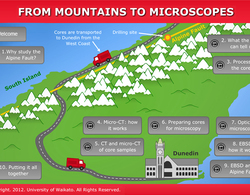Transcript
Andrew McNaughton
The key advantages of micro-CT is that you can reconstruct a very accurate three-dimensional model of a life-sized object. Micro-CT works by taking a series of X-rays around an axis of rotation. So the easiest way would be to imagine a rubber duck in a paper bag and a ring of cardboard around it. If you got a really strong torch and shone it through the bag, you’d get a shadow on the ring of cardboard and then if you move the torch around another few degrees, you get another shadow but the shadow would be slightly different because you’ve taken it from a different angle. So then if you went round in a series of rotations right around, you’d get a whole ring of shadows. So each of those shadowswould represent the same object but from a different angle. So the micro-CT works the same way except you’re using X-rays instead of light, so you get a ring of X-rays, and then you recreate what the original object looked like, because you know the angle and you know the direction that it was taken. Then you can go in and see the internal detail, so that’s the biggest advantage you’ve got. Everything in its place where it should be, you can really burrow into the bits you’re interested in.
Acknowledgements
Andrew McNaughton, Microscopy Otago, University of Otago.
3D animation of micro CT sample, by Hannah Scott, University of Otago.


